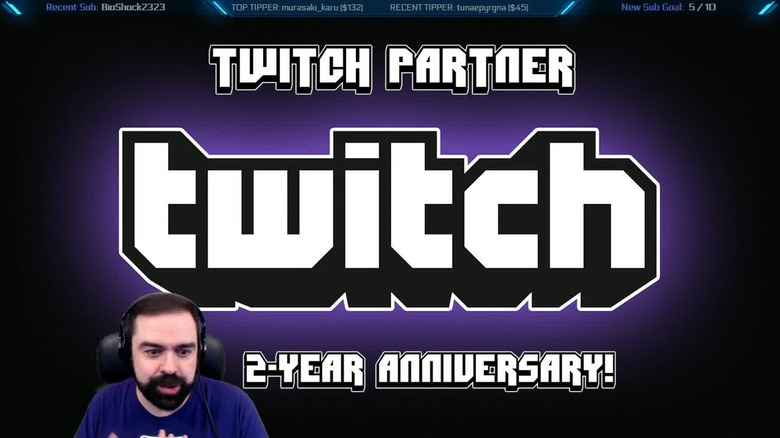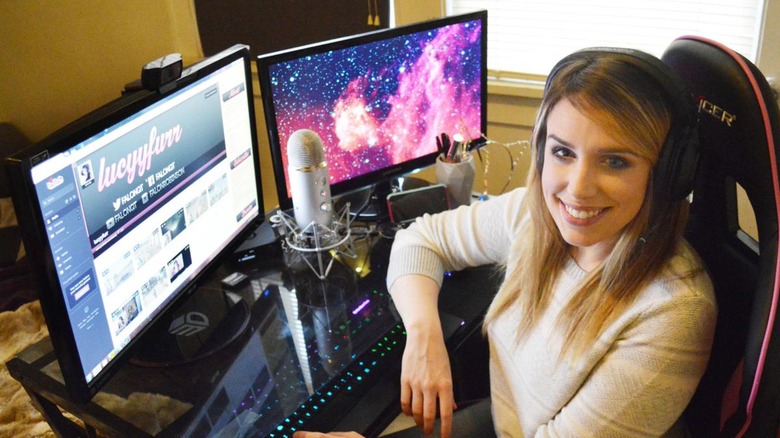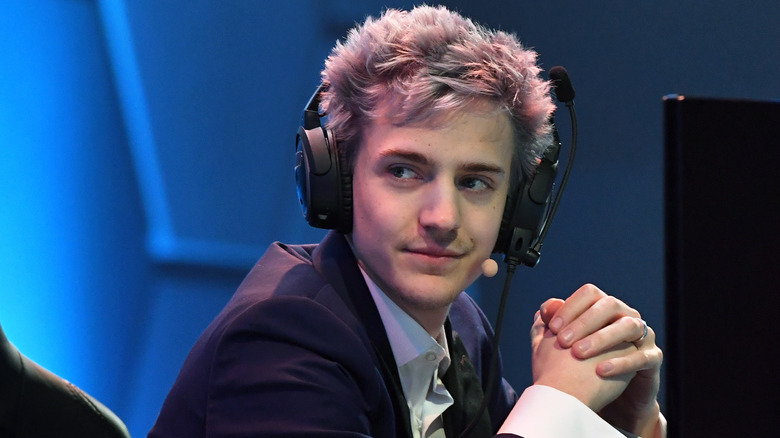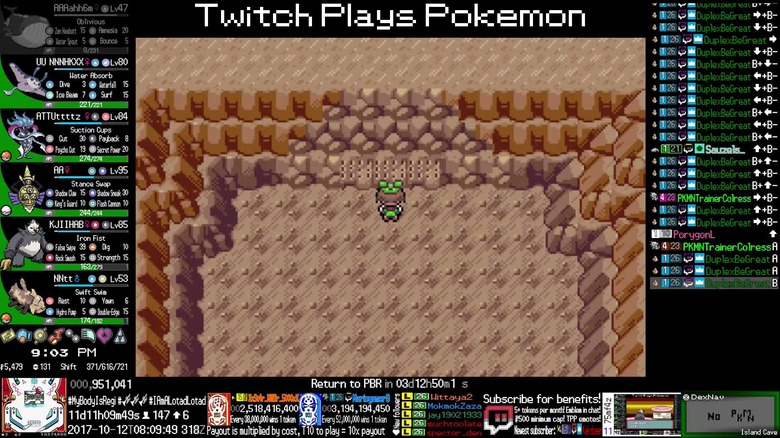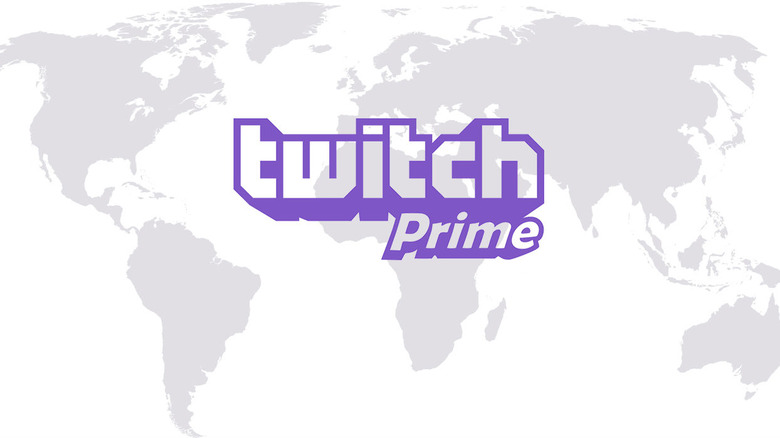The Untold Truth Of Twitch
"Wait... people enjoy watching other people play video games? They do that for fun?"
You may know someone who — in utter disbelief — asked questions like the ones above. And let's be honest: the concept of Twitch does seem to defy the very idea behind video games, doesn't it? Games are supposed to let you do the things you can't do otherwise. They turn you into the hero in the world of James Bond. They let you throw the winning touchdown pass in the Super Bowl, even if you can't physically throw a football more than five yards. And they put you behind the wheel of the fastest, most expensive car on earth — even if you can't afford it or the bail you'd need to pay for going 200 MPH through a city.
But Twitch — and video game streaming in general — is big business, and people like to tune in and watch their favorite streamers. A lot of people. Like, more-average-viewers-than-CNN numbers of people. And Twitch, to this day, is still growing.
We've put together a list of some unknown and incredible facts about Twitch, including some related to how the service got its start, how it's evolved over the years, and how it's managed to stir up some controversy along the way.
Ready? Let's dive in.
Twitch is a spin-off of the now-defunct Justin.TV
Believe it or not, live streaming was around long before Twitch came into existence. And there was a subset of the online video streaming community that helped shape what eventually became game streaming. These Internet pioneers were called "lifestreamers," and there's perhaps no bigger, more well-known person in that category than stream queen iJustine, who got her start on the Justin.TV platform.
Justin.TV played home to lifestreamers on the regular, and once some of these streamers combined their broadcasts of every day life with their play of video games, Justin.TV saw an opportunity. It started at first as a separate category on the Justin.TV website, but was eventually spun off into its own separate service dedicated solely to video game streaming. That service was called Twitch.
The rest is history. Twitch was the service with the most upside, and Justin.TV eventually shut down so the team could put all of its focus on growing and sustaining Twitch as a home for those streaming video games on the Web.
Day9tv was the first Twitch streamer to get a "subscription" button
Sure, Twitch has been around for several years now, but Twitch in its current form hasn't. For instance, there was not always a "subscription" button for high-profile streamers on the service. So who was the first Twitch streamer to ever get a subscription button for their channel?
The answer, as it turns out, is someone named Sean Plott, or — as he's better known — Day[9].
Day[9]'s channel, day9tv, was the first one awarded with a sub button. But it wasn't as simple as checking a box for the team at Twitch, according to Twitch CEO Emmett Shear. "We built the feature in collaboration with him," Shear told a user on reddit. "For a while he was the only channel with a sub button because we'd hard coded a lot of stuff."
Twitch must have liked the idea of user subscriptions, because the idea eventually expanded out to include more people as the service grew. We'll get to that next.
Twitch launched its "partner" revenue sharing program in 2011
For those who want to be full-time game streamers, attaining the level of "Twitch Partner" is the ultimate achievement. And back when the partnership program originally launched in 2011, there were some set requirements in place for those interested. Streamers needed to average at least 500 concurrent viewers, have 1,000 followers, and reach 300,000 total channel views. It was quite the hill to climb back then, but plenty of streamers got it done and went on to build up huge audiences.
These days, Twitch is a little more vague with its Partner requirements. The company now states in its FAQ pages that content, average viewer count, and stream frequency are all factors that are considered when someone applies to the program. But when it comes to specific numbers, Twitch now says that it doesn't use them anymore. Instead, Twitch looks at applications "on a case by case basis," and a denial one week doesn't necessarily mean a hopeful streamer won't get approved the next.
Female streamers face a whole lot of sexism on Twitch
Over many, many years, the video game community built up a reputation for being a place for boys. It was never true, as you could quite easily find female gamers who enjoyed the medium just as much as their male counterparts. But the idea stuck, and in some ways, there was a little truth to it in that females almost overwhelmingly found themselves singled out when playing online.
If we treat Twitch as a microcosm of the gaming community as a whole, then viewing how its female streamers are treated compared to males can help shine some light on the sexism in games. And, not surprisingly, female streamers on Twitch have to deal with boatloads of unwanted behavior from those who tune in to their channels.
An Indiana University report found that female streamers "are characterized by words about physical appearance, the body, relationships, and greetings while male channels are characterized by game-related words," and "the content in female channels share common words that signal objectification."
Long story short: women on Twitch have to field a lot of chat commentary that is more about them then the game they're playing, and men on Twitch don't run into that problem anywhere near as often.
Ninja reportedly makes over $560,000 per month on Twitch
We've covered Tyler "Ninja" Blevins pretty extensively in the past, and for good reason: he's arguably the biggest name in video game streaming right now. And so it should come as no shock that he makes his home primarily on Twitch, where you can find him playing Fortnite with the likes of rapper Drake and NFL wide receiver JuJu Smith-Schuster.
What does being a huge Twitch streamer net you in terms of revenue, though? That's a question that Ninja actually answered pretty honestly in an interview with CNBC. According to Ninja, he rakes in over $500,000 per month thanks to streaming, with a large portion of that coming from his Twitch subscriber base.
There are some other streamers making a lot of dough on Twitch, as well. Dr. DisRespect, another well-known streamer, is reported to make around $120,000 a month courtesy of his Twitch subscribers, and streamer Summit1G is estimated to make approximately $75,000 a month from his.
The "Twitch Plays Pokemon" stream hit over 6.5 million views in five days
Are you someone who doesn't like your friends "backseat gaming" while you play through a title? Then you probably wouldn't have wanted to take part in Twitch Plays Pokemon, which put the 1996 classic Pokemon Red on Twitch with the premise that the community had to play together and vote on button commands and strategy.
The channel for Twitch Plays Pokemon called the exercise a "social experiment," and boy, was it ever. The stream hit over 6.5 million total views while the event was running, and over 2.5 million button presses were logged from viewers around the world. And in case you're wondering — yes, the Twitch community did eventually take down the Elite Four and complete the game in a bit over half a month. The total completion time clocked in at 16 days, 9 hours, 55 minutes, and 4 seconds, proving that if we all put aside our differences with a common goal in mind, anything's possible.
Twitch became a battleground between Google and Amazon
Just a few years after spinning off from Justin.TV, Twitch was growing rapidly and pulling in huge amounts of viewers. So many viewers, in fact, that the company started to draw attention from larger Web companies. In a bit of premature reporting, several outlets confirmed in 2014 that Google had plunked down a cool $1 billion to acquire Twitch, giving the Mountain View giant another major video property next to YouTube. And based on Google's history in online video, the move seemed like a great fit.
Seemingly out of nowhere, Jeff Bezos and his online retail powerhouse Amazon swooped in and snatched Twitch away from Google. Amazon reportedly sealed the deal with Twitch for less money — $970 million — because an acquisition by Amazon would result in less anti-trust scrutiny, and because Amazon vowed to largely leave Twitch independent after the purchase. It was a whirlwind series of events, for sure, but one that ensured Twitch could continue to grow while following its own vision.
Twitch owns the rights to stream artist Bob Ross' content — and continues to do so to this day
Those of you who've ever watched PBS may be familiar with classics like Sesame Street and Mister Roger's Neighborhood. But another well-known and well-loved show existed on the network from 1983 to 1994, too. It was called The Joy of Painting, and it starred the most relaxing man in the business, artist Bob Ross.
Ross passed away in 1995, but he continues to live on not only in our memories, but also online thanks to Twitch. In 2015, the video game streaming service expanded its video categories to include creative streams, and it obtained the rights to rebroadcast The Joy of Painting for a run of the entire series to celebrate. The streams became so popular, however, that Twitch decided to keep Ross' show around for good. So if you're looking for a calm place to hang out and watch someone who loved to share his craft with the world, the Bob Ross Twitch channel is still showing every single episode of his show — from all 31 seasons.
The rise of Twitch brought the crime of "swatting" to the mainstream
Twitch exists on the internet, so it's not unexpected that there are some bad apples both in its stable of streamers and in those who view content on the platform. But some Twitch audience members have taken things way too far in the past, letting personal grudges with streamers spill over into situations that are life threatening. Simply put: without Twitch, we wouldn't be nearly as familiar with "swatting" as we are today.
The act of swatting a streamer involves having a police SWAT team show up at their door. The viewer calls the local police station in the streamer's city or town and essentially acts out a dangerous situation that requires law enforcement intervention. What played out for Joshua Peters, a streamer who goes by the name Koopatroopa787, was that he didn't even hear the police show up by the time they'd already entered his home and drawn weapons on members of his family.
Peters was incredibly lucky. No one was hurt, and as soon as Peters mentioned he was streaming on Twitch, officers recognized it as a swatting incident. But a Kansas man wasn't so fortunate, falling victim to an incident of swatting in which he wasn't even the target. After an online dispute around a Call of Duty match escalated, a swatter sent police to the home of 28-year-old Andrew Finch, an unrelated third party. Finch was gunned down by police at his front door, and the swatter, Tyler Barriss, now faces manslaughter charges.
Many Twitch streamers were not happy about the addition of the "IRL" category
A whole lot of time and dedication goes into building a Twitch community. Quite a few streamers set out with the hopes of becoming full-time streamers but ultimately flame out because of the time commitment involved. It's understandable, then, that those who've "made it" are somewhat protective of what they've built, and that they might have some things to say when Twitch ventures into uncharted territory with its offerings.
The "IRL" (in real life) category first launched in late 2016. And to say that most streamers who focused on games were not happy about it? That might be an understatement.
For Twitch, it was really a blast from the past. As we discussed earlier, Twitch was a spin-off of what was effectively a "life-streaming" site, Justin.TV. That Twitch would eventually return to its vlogging roots, given the popularity of the genre on YouTube, didn't seem all that surprising.
But Twitch streamers definitely had some bones to pick about the move. Some pointed to the highly controversial content being put out by newcomers to the platform. And other well-established streamers, like Professor Broman, penned screeds about how the IRL category would disrupt the work-life balance of streamers. Broman's argument was, in essence, that viewers would expect him to stream even when he wasn't gaming because the IRL category now existed.
The Twitch IRL category is still up and running to this day, though viewer counts suggest it's nowhere as near as popular as gaming content.

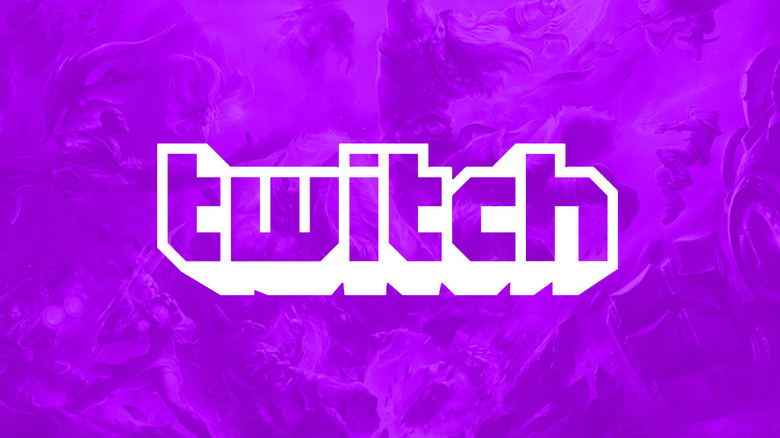

![Day[9]](https://www.svg.com/img/gallery/the-untold-truth-of-twitch/day9tv-was-the-first-twitch-streamer-to-get-a-subscription-button-1526072501.jpg)
